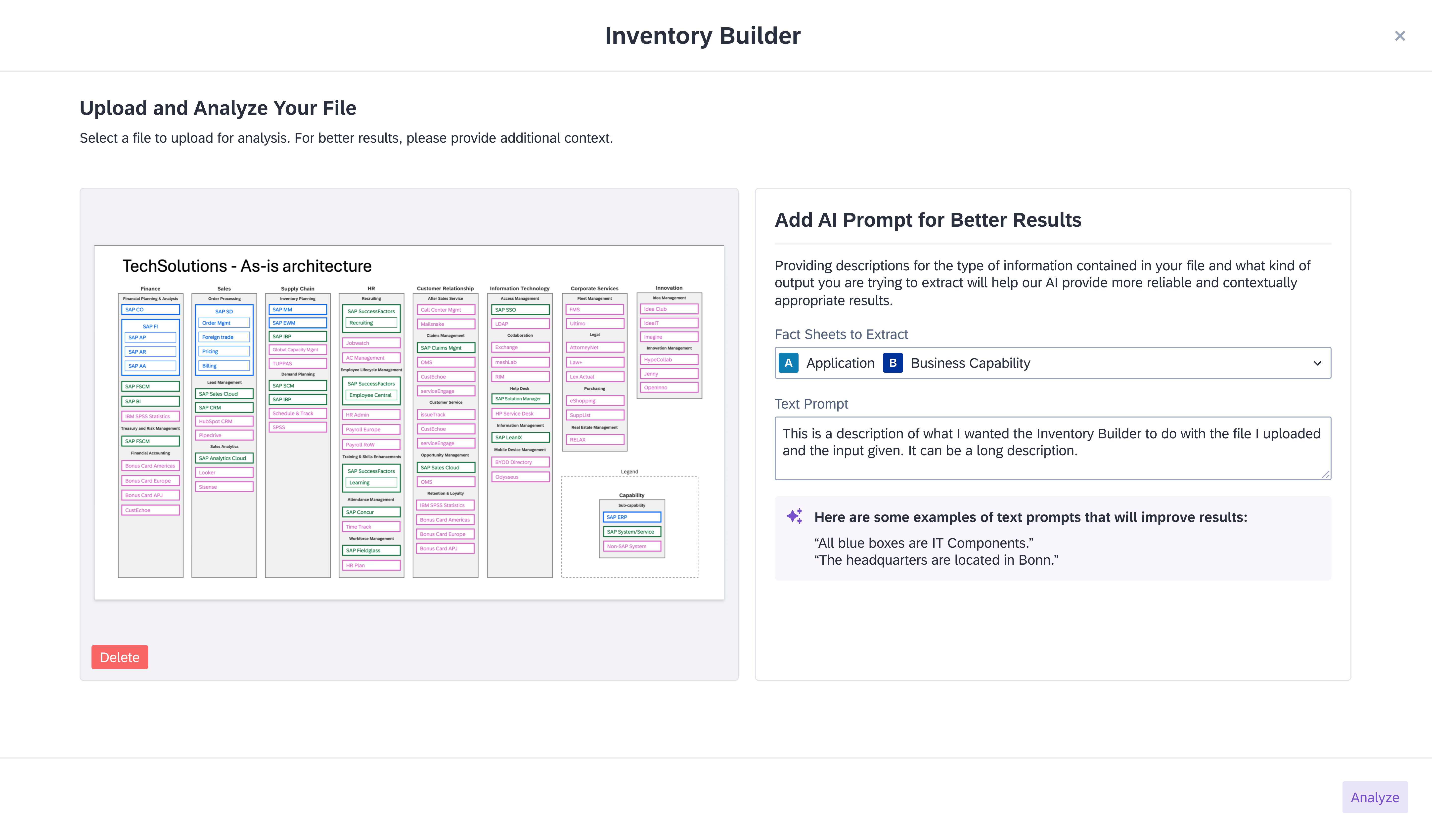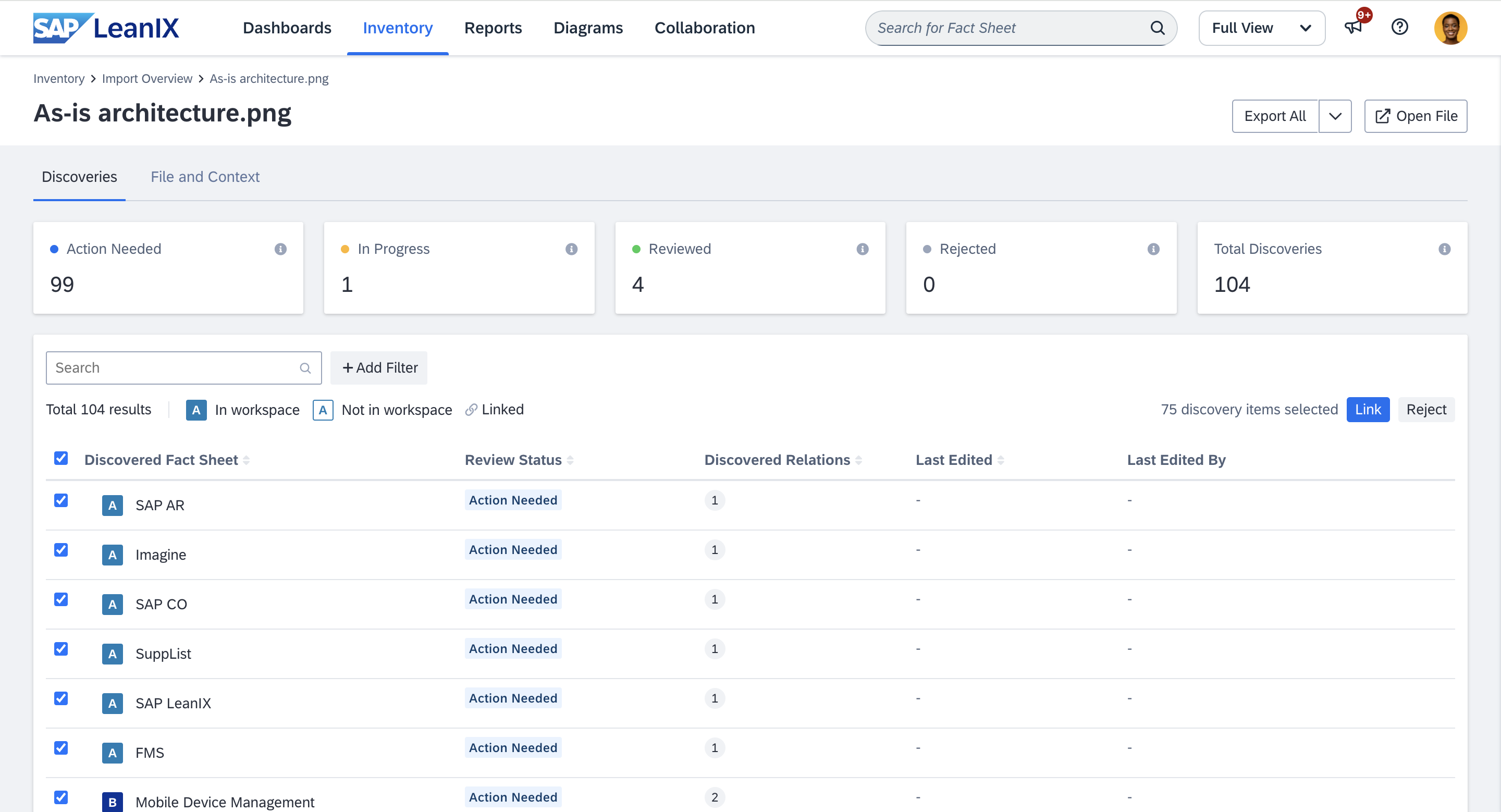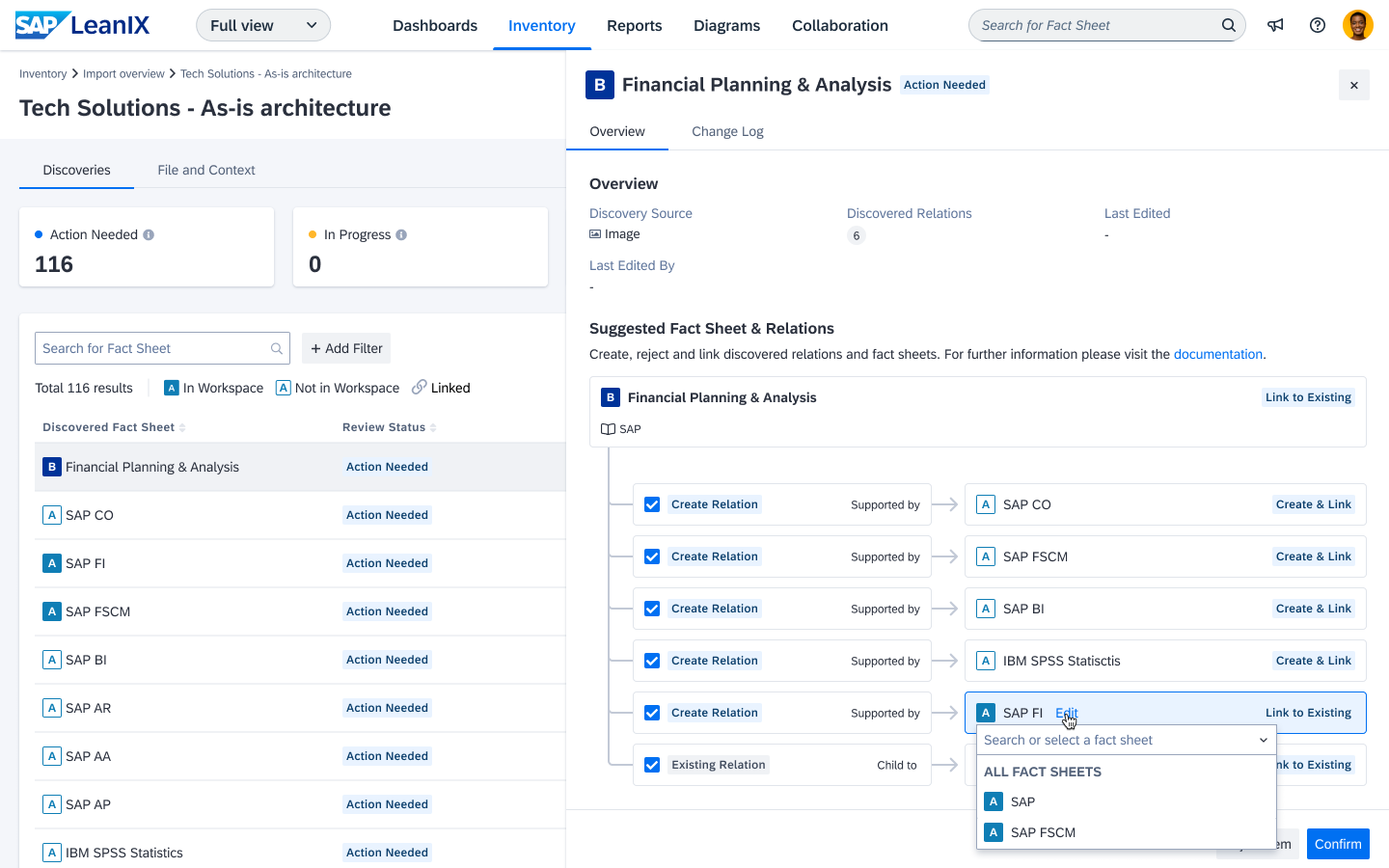Inventory Builder
Inventory builder uses AI to analyze diagrams, images, and text-based files, to extract fact sheets and relations, and accelerate building inventory. You can review, adjust, and create fact sheets efficiently from discovered data.
Introduction
Inventory builder uses AI to analyze diagrams, images, and text-based file formats to automatically extract relevant architectural elements. The analysis discovers appropriate fact sheets and their relationships, which you can review and create corresponding fact sheets to accelerate your inventory-building process.
Benefits
- Simplify inventory building: Building the inventory is time-consuming and complex as it involves collecting and structuring data from various artifacts like data flow diagrams, value stream charts, and images. Inventory builder simplifies this by automatically transforming unstructured data into structured information in the form of fact sheets and relations.
- Speed up adoption and maintenance: Automated discovery and creation of architectural elements accelerate stakeholder onboarding and adoption, inventory maintenance, and data editing tasks within your organization.
Note
You need to activate the feature in the Optional Features & Early Access section of admin settings. For a detailed guide, see Activating AI Capabilities.
To learn more about data handling, privacy, and legal concerns, see Frequently Asked Questions on AI Capabilities.
Extracting Fact Sheets and Relations from the Documents
To extract architectural elements from documents, you upload your file and provide additional context about its content. Upon uploading the file, the system automatically suggests the types of fact sheets being extracted. You can modify the scope by adding more fact sheet types and subtypes or removing the suggested ones. All fact sheet types defined in the meta model—whether default or custom— are detected. For best results with custom types, we recommend including a brief definition in your prompt.
The inventory builder then analyzes the document and suggests lists of fact sheets and relations that can be derived from it. It currently supports JPEG, JPG, PNG, CSV, XML, TXT, MD, and JSON file formats.
To upload and analyze the file, do the following:
- In the inventory, from the drop-down menu next to Add Fact Sheet button, select Inventory Builder

- On the resulting page, click Import.
- Upload your file by either dragging and dropping it or browsing your system.
- Optionally, modify the scope of fact sheet types to be extracted by adjusting the ones automatically suggested by the system. Fact sheets of specified fact sheet types are then extracted.
- Optionally, provide additional context and specific instructions through prompts to significantly improve the results. For example, you could highlight specific details in the diagram, such as specifying that dotted lines represent a relation or providing other relevant clarifications. For good examples, see Best Practice Prompts for Using Inventory Builder Effectively.
- Click Analyze.

Uploading the File and Providing Prompts for Analysis.
- On the resulting page, you get an overview of discovered fact sheets and relations. If needed, you can rerun the analysis by clicking Analyze again and refining the prompt.
- When you're satisfied with the results, proceed further by clicking Push to Inbox. In the inbox, you can review the fact sheets and relations in detail and decide whether you want to create them in your workspace.
Creating Fact Sheets and Relations from the Inventory Builder Inbox
The Discoveries tab in the inventory builder inbox lists all the discovered fact sheets. By clicking on a fact sheet, you can view its details in the right-side pane, including the source of discovery, suggested fact sheet relations, and whether the fact sheet and its relations already exist or not. You can choose to either review each discovered item individually to create fact sheets and relations or create several fact sheets and relations at once.

Inventory Builder Inbox
Individually Reviewing and Creating Fact Sheets and Relations
- Click on a fact sheet to open the right-side panel.
- Review the proposed fact sheets and relations.
While reviewing, you can make the following changes:- Link the discovered fact sheet to a different fact sheet than the suggested one: Hover over the suggested fact sheet, click Edit, then search for and select an alternative fact sheet.
- Reject a relation: Uncheck the check box against the relation you want to avoid creating.
- Modify the target fact sheet of a relation: Hover over the suggested target fact sheet on the right, click Edit, then search for and select a different fact sheet.

Reviewing the Proposed Fact Sheets and Relations
- After reviewing and making necessary adjustments, click Confirm at the bottom to create the fact sheets and relations.
Creating Fact Sheets and Relations for Multiple Items
- In the inbox, use the checkboxes next to each item to select multiple fact sheets from the list.
- Click Link at the top to create the fact sheets and relations in bulk.
Rejecting Discovered Items
Promptly rejecting discovered fact sheets that you do not want to create helps maintain a manageable list and makes it easier to identify and handle newly discovered fact sheets.
To reject a fact sheet, select the item to open the right-side pane and click Reject Item at the bottom.
Accessing Past Uploads and Analysis
You can access past uploads and analyses by clicking Inventory Builder - Import Overview in the right-side pane of the inventory. From this import overview, you can open the corresponding inbox for any item to continue reviewing and creating fact sheets and relations at any time.
The status of each file helps you track its progress in the inventory builder workflow:
- Uploaded: File uploaded, but no further action was taken.
- Analyzed: File analyzed, but discovered items not yet added to the inbox.
- Ready for review: Discovered items added to the inbox but not yet reviewed.
- Reviewed: All discovered fact sheets and relations have been reviewed (either added to the inventory or rejected).
- Error: Something went wrong while linking the discovery item to fact sheets or creating its relations. Try to link or create the affected item again.
Best Practice Prompts for Using Inventory Builder Effectively
Using well-crafted prompts significantly improves the analysis of enterprise architecture diagrams and images, enabling the inventory builder to accurately extract relevant architectural elements for each fact sheet type. To explore sample prompts for various fact sheet types, see Sample Prompts for the Inventory Builder.
Updated 2 days ago
